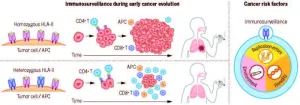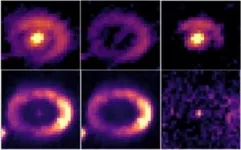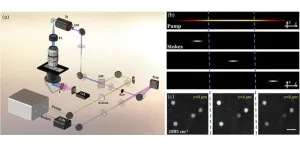New York, NY (February 22, 2024)—Recent developments in cancer research have highlighted the vital role of the immune system, particularly in the notable successes of cancer immunotherapy.
Now, a paradigm-shifting study led by researchers at the Icahn School of Medicine at Mount Sinai in New York in collaboration with the University of Helsinki and Massachusetts General Hospital sheds light on how variations in immune genetics influence lung cancer risk, potentially paving the way for enhanced prevention strategies and screening.
The findings were described in the February 22 online issue of Science [DOI number: 10.1126/science.adi3808].
The investigators utilized genetic epidemiology and multimodal genomic analyses of data from the UK Biobank, validating it in FinnGen. Their study focused on human leukocyte antigen (HLA) molecules—the most diverse genes in the human genome and at the core of immune recognition. These genes contain instructions to make proteins, which play a crucial role in presenting foreign antigens on cell surfaces. This process aids the immune system in identifying and eliminating threats such as cancer cells.
Surprisingly, the study found that individuals with heterozygosity (having different versions of a gene) at HLA-II, rather than HLA-I, experienced a decreased risk of lung cancer. This effect was particularly pronounced among smokers, a population already at higher risk for lung cancer due to exposure to carcinogens.
"Our findings challenge conventional thinking by demonstrating that immune genetics, specifically HLA-II heterozygosity, plays a significant role in lung cancer risk, especially among smokers," says co-senior author Diego Chowell, PhD, Assistant Professor of Oncological Sciences, and Immunology and Immunotherapy at Icahn Mount Sinai. “Further, when we added polygenic risk scores—which is a measure of genetic predisposition based on multiple genes—to the analysis, it increased the lifetime risk of lung cancer, specifically in smokers who have identical versions of the HLA-II genes.
The implications of this research extend beyond lung cancer, offering a new perspective on cancer risk assessment, the researchers say. The conventional thinking on the causes of cancer is that the disease is caused by random mutations arising during DNA replication, inherited mutations, and environmental factors. The research showed that the immune system is also part of the etiology of cancer, Dr. Chowell says. By considering immune genetics alongside hereditary and environmental factors, the investigators’ aim to develop more effective prevention strategies, potentially harnessing the immune system to combat cancer.
"These results highlight a previously overlooked aspect of cancer risk assessment," says co-senior author Robert Samstein, MD, PhD, Assistant Professor of Radiation Oncology, and Immunology and Immunotherapy at Icahn Mount Sinai. "Our study marks a big step toward understanding the intricate interplay between the immune system and cancer risk. We hope that by identifying individuals with increased susceptibility based on their immune genetics, we can implement more targeted screening, prevention, and treatment strategies."
Next, the research team plans to delve deeper into the mechanisms underlying HLA heterozygosity's protective effects, with a focus on preclinical models of disease. Additionally, they aim to explore the role of non-classical CD4 T cells and HLA class II in cancer biology, opening the door for potential progress in the mitigation and treatment of cancer.
The paper is titled “An immunogenetic basis for lung cancer risk.”
The remaining authors of the paper, all with Icahn Mount Sinai except where indicated, are: Chirag Krishna, PhD (Pfizer); Anniina Tervi, PhD (University of Helsinki); Miriam Saffern (PhD candidate); Eric A. Wilson, PhD; Seong-Keun Yoo, PhD; Nina Mars, MD, PhD (University of Helsinki and The Broad Institute of Harvard and MIT); Vladimir Roudko, PhD; Byuri Angela Cho, PhD; Samuel Edward Jones, PhD (University of Helsinki); Natalie Vaninov (PhD candidate); Myvizhi Esai Selvan, PhD; Zeynep H Gümüs, PhD; FinnGen Consortium; Tobias L. Lenz, PhD (University of Hamburg); Miriam Merad, MD, PhD; Paolo Boffetta, MD (Stony Brook University in New York and University of Bologna); Francisco Martínez-Jiménez, PhD (Stony Brook University in New York and Vall d’Hebron Institute of Oncology, Barcelona); and Hanna M. Ollila, PhD (Massachusetts General Hospital, Harvard Medical School, The Broad Institute, and University of Helsinki).
Please see Science [DOI number: 10.1126/science.adi3808] to view details on funding and competing interests.
More information, including a copy of the paper, can be found online at the Science press package at https://www.eurekalert.org/press/scipak/.
-####-
About UK Biobank
UK Biobank is a large-scale biomedical database and research resource containing anonymised genetic, lifestyle and health information from half a million UK participants. UK Biobank’s database, which includes blood samples, heart and brain scans and genetic data of the volunteer participants, is globally accessible to approved researchers who are undertaking health-related research that’s in the public interest. UK Biobank’s resource was opened for research use in April 2012. Since then, 30,000 researchers from 100 countries have been approved to use it and more than 6,000 peer-reviewed papers that used the resource have now been published. You can find out more about UK Biobank at http://www.ukbiobank.ac.uk
About the Icahn School of Medicine at Mount Sinai
The Icahn School of Medicine at Mount Sinai is internationally renowned for its outstanding research, educational, and clinical care programs. It is the sole academic partner for the eight- member hospitals* of the Mount Sinai Health System, one of the largest academic health systems in the United States, providing care to a large and diverse patient population.
Ranked 13th nationwide in National Institutes of Health (NIH) funding and among the 99th percentile in research dollars per investigator according to the Association of American Medical Colleges, Icahn Mount Sinai has a talented, productive, and successful faculty. More than 3,000 full-time scientists, educators, and clinicians work within and across 44 academic departments and 36 multidisciplinary institutes, a structure that facilitates tremendous collaboration and synergy. Our emphasis on translational research and therapeutics is evident in such diverse areas as genomics/big data, virology, neuroscience, cardiology, geriatrics, as well as gastrointestinal and liver diseases.
Icahn Mount Sinai offers highly competitive MD, PhD, and Master’s degree programs, with current enrollment of approximately 1,300 students. It has the largest graduate medical education program in the country, with more than 2,000 clinical residents and fellows training throughout the Health System. In addition, more than 550 postdoctoral research fellows are in training within the Health System.
A culture of innovation and discovery permeates every Icahn Mount Sinai program. Mount Sinai’s technology transfer office, one of the largest in the country, partners with faculty and trainees to pursue optimal commercialization of intellectual property to ensure that Mount Sinai discoveries and innovations translate into healthcare products and services that benefit the public.
Icahn Mount Sinai’s commitment to breakthrough science and clinical care is enhanced by academic affiliations that supplement and complement the School’s programs.
Through the Mount Sinai Innovation Partners (MSIP), the Health System facilitates the real-world application and commercialization of medical breakthroughs made at Mount Sinai. Additionally, MSIP develops research partnerships with industry leaders such as Merck & Co., AstraZeneca, Novo Nordisk, and others.
The Icahn School of Medicine at Mount Sinai is located in New York City on the border between the Upper East Side and East Harlem, and classroom teaching takes place on a campus facing Central Park. Icahn Mount Sinai’s location offers many opportunities to interact with and care for diverse communities. Learning extends well beyond the borders of our physical campus, to the eight hospitals of the Mount Sinai Health System, our academic affiliates, and globally.
-------------------------------------------------------
* Mount Sinai Health System member hospitals: The Mount Sinai Hospital; Mount Sinai Beth Israel; Mount Sinai Brooklyn; Mount Sinai Morningside; Mount Sinai Queens; Mount Sinai South Nassau; Mount Sinai West; and New York Eye and Ear Infirmary of Mount Sinai.
END





